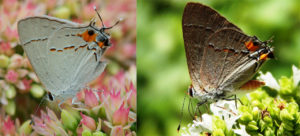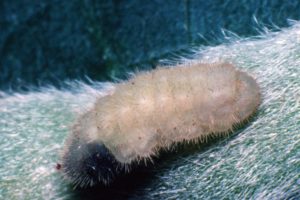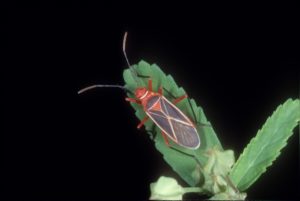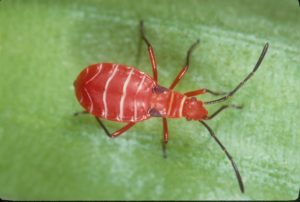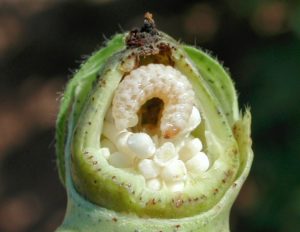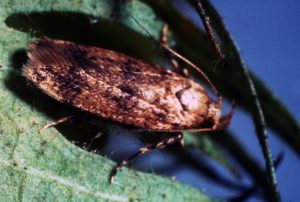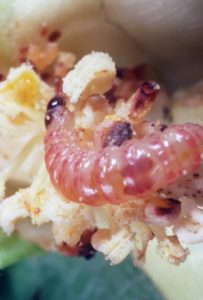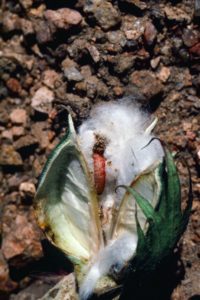Cutworms
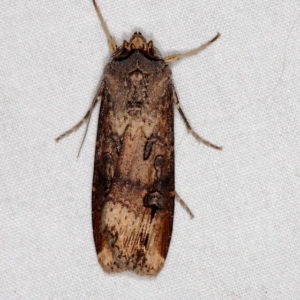
Several species of cutworms infest cotton. The adult cutworm is a robust brown to gray moth (Fig. 62). When disturbed, cutworm larvae curl up into a C-shape and regurgitate. The larvae are often shiny or glossy and always have four pairs of prolegs (Fig. 63).
Cutworms usually cut off seedling cotton plant stems at the soil surface. The resulting stand reduction may be more visible at field margins and in low-lying, weedy areas. On rare occasions, cutworm damage can be severe enough to require replanting.
In no-till or limited-till situations, cutworms can establish on existing vegetation and move to emerging cotton seedlings when that vegetation dies. Reduce the risk of cutworm attack by destroying all existing vegetation 3 to 4 weeks before planting.
Chemical Control and Action Threshold
Treat for cutworms if infestations threaten to reduce the stand below 35,000 plants/acre (on an average 2.68 plants/row foot with 40-inch row spacing) in a field or part of a field.
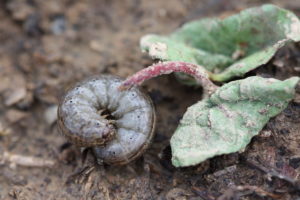
Saltmarsh Caterpillar
The larval stages of the saltmarsh caterpillar and the banded woolly bear are called woolly bears because of the long hairs covering their bodies. They are dark-headed, woolly, yellow, gray, black, or reddish- brown (some with rusty red and black bands) (Fig. 64 and 65). We will discuss both species as saltmarsh caterpillars because of their similar appearance, biology, and the damage they inflict.
The saltmarsh caterpillar is a problem on the edges of fields and where alternate host plants are available. Early in the growing season, large populations can develop in outbreak years, destroying plant stands along the field edges.
Treating isolated areas within a field or along the field borders effectively controls saltmarsh caterpillars and reduces their spread across fields.
Cotton Square Borer
The adult cotton square borer is a slate or bluish- gray butterfly. It has two large black spots on each wing with smaller reddish-orange spots above these at the back edge of the hind wing. There are usually two or three thin tails that mimic antennae on the hind wing (Figs. 66 and 67). The larval stage is a velvety, light green, slug-shaped worm (Fig. 68).
The adult begins laying eggs early in the spring. They take about 6 days to hatch; then the small larvae feed on cotton squares for around 20 days. The presence of adult butterflies is usually the first indication of cotton square borer activity. However, hollowed-out squares with almost perfectly round entrance and exit holes are another sign. Unlike bollworm or tobacco budworm damage, there is no frass (the excrement of insect larvae) present with cotton square borer damage. Insecticide treatment for cotton square borer control is almost never necessary in Texas.
Cotton Stainer
The cotton stainer is a true bug (has piercing-sucking mouthparts). The head and pronotum are bright red; the remainder of the body is dark brown crossed with pale yellow lines (Fig. 69). Immature stages are smaller but resemble adults without wings (Fig. 70).
The cotton stainer damages developing bolls by puncturing seeds and causing plant sap to exude from the feeding site. The plant sap stains the lint an indelible yellow. Feeding by the cotton stainer also interferes with the bolls’ natural development. In recent years, the cotton stainer has been rare in Texas cotton.
Whiteflies
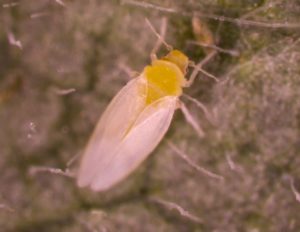
Silverleaf whitefly (SLWF) and bandedwing whitefly (BWWF) are the two most common whitefly species that infest Texas cotton.
Both whitefly species are similar in appearance and basic biology. The adults of both species resemble tiny white moths with yellowish bodies, about 1/16 to 1/10 of an inch long. Their wings fold roof-like over their abdomens. The SLWF (Fig. 71) has solid white wings, and the BWWF has grayish-brown colored bands across its wings.
The nymphs are flat, scale-like insects, usually about 1/30 of an inch long (Fig. 72). The immatures feed with sucking mouthparts on the underside of leaves. Damage ranges from stunted growth and reduced plant vigor during the early season to reduced plant vigor, honeydew deposited on open cotton lint (sticky cotton), and premature defoliation during the mid and late season. Like aphid honeydew, whitefly honeydew is a food source for black sooty molds that can stain lint and reduce fiber quality. Heavy whitefly infestations can severely reduce cotton yield.
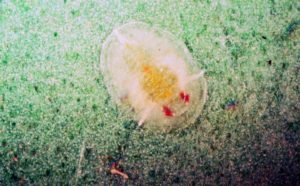
Scouting
To sample for whiteflies:
- Examine the underside of at least 30 key leaves (leaves located at the fifth node down from the terminal) and note how many leaves are infested with at least three adults.
- Use a hand lens to examine a quarter-sized area on the underside of the leaf between the main middle vein and one of the main lateral veins.
- Note how many hand-lens views contain at least one large whitefly nymph (third and fourth instars).
Boll Weevil
Boll weevils have been declared eradicated in the West Texas region. In 2016, the only zones in the United States to capture weevils were the Lower Rio Grande Valley and South Texas/Winter Garden zones (Fig. 73). Contact your local AgriLife Extension office or the Texas Boll Weevil Eradication Foundation (325-672-2800) for information.
Pink Bollworm
The pink bollworm has been eradicated from the southwestern United States (Figs. 74–77). Contact your local AgriLife Extension office for information.


